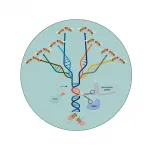Healthy diet before, during pregnancy linked to lower complications, NIH study suggests
2021-06-02
(Press-News.org) A healthy diet around the time of conception through the second trimester may reduce the risk of several common pregnancy complications, suggests a study by researchers at the National Institutes of Health. Expectant women in the study who scored high on any of three measures of healthy eating had lower risks for gestational diabetes, pregnancy-related blood pressure disorders and preterm birth. The study was conducted by Cuilin Zhang, M.D., Ph.D., and colleagues at NIH's Eunice Kennedy Shriver National Institute of Child Health and Human Development (NICHD). It appears in the American Journal of Clinical Nutrition.
The researchers analyzed dietary data collected multiple times during pregnancy from the NICHD Fetal Growth Study. Nearly 1,900 women responded to questionnaires on their diets at eight to 13 weeks of pregnancy and were asked to estimate what they ate in the previous three months. At 16 to 22 weeks and 24 to 29 weeks, the women identified what they ate in the previous 24 hours. Their responses were scored according to three measures of healthy eating: the Alternate Healthy Eating Index (AHEI), Alternate Mediterranean Diet (AMED), and Dietary Approaches to Stop Hypertension (DASH) diet. All three measures emphasize consumption of fruits, vegetables, whole grain, nuts and legumes while limiting red and processed meat.
Overall, the researchers found that following any of the diets around the time of conception through the second trimester was associated with a lower risk of gestational diabetes, hypertension, preeclampsia and preterm delivery. For example, women with a high AHEI score at 16 to 22 weeks had a 32% lower risk for gestational diabetes than women with a low AHEI score. Women with a high DASH score at eight to 12 weeks and 16 to 22 weeks had a 19% lower risk for pregnancy-related high blood pressure disorders. A high AMED score at 24 to 29 weeks or a high DASH score at 24 to 29 weeks was associated with a 50% lower risk for preterm birth.
INFORMATION:
WHO:
Cuilin Zhang, M.D., Ph.D., M.P.H, Acting Chief, NICHD Epidemiology Branch, is available for comment.
ARTICLE:
Li, M. Healthy dietary patterns and common pregnancy complications: a prospective and longitudinal study. American Journal of Clinical Nutrition. 2021.
About the Eunice Kennedy Shriver National Institute of Child Health and Human Development (NICHD): NICHD leads research and training to understand human development, improve reproductive health, enhance the lives of children and adolescents, and optimize abilities for all. For more information, visit https://www.nichd.nih.gov.
About the National Institutes of Health (NIH): NIH, the nation's medical research agency, includes 27 Institutes and Centers and is a component of the U.S. Department of Health and Human Services. NIH is the primary federal agency conducting and supporting basic, clinical, and translational medical research, and is investigating the causes, treatments, and cures for both common and rare diseases. For more information about NIH and its programs, visit https://www.nih.gov.
ELSE PRESS RELEASES FROM THIS DATE:
2021-06-02
A team of students working with Jonathan Boreyko, associate professor in mechanical engineering at Virginia Tech, has discovered the method ducks use to suspend water in their feathers while diving, allowing them to shake it out when surfacing. The discovery opens the door for applications in marine technology. Findings were published in ACS Applied Materials & Interfaces.
Boreyko has a well-established body of work in the area of fluid mechanics, including the invention of a fog harp and the use of contained, recirculated steam as a cooling device. As his research has progressed throughout the past decade, the mechanics of duck de-wetting has been one of his longest-running projects.
"I got this idea when I was at Duke University," ...
2021-06-02
Jack Tseng loves bone-crunching animals -- hyenas are his favorite -- so when paleontologist Joseph Peterson discovered fossilized dinosaur bones that had teeth marks from a juvenile Tyrannosaurus rex, Tseng decided to try to replicate the bite marks and measure how hard those kids could actually chomp down.
Last year, he and Peterson made a metal replica of a scimitar-shaped tooth of a 13-year-old juvie T. rex, mounted it on a mechanical testing frame commonly used in engineering and materials science, and tried to crack a cow legbone with it.
Based on 17 successful attempts to match the depth and shape of the bite marks on the fossils -- he had to toss out some trials because the fresh bone slid around too much -- he determined that a juvenile could have exerted ...
2021-06-02
ALBUQUERQUE, N.M. -- Scientists at Sandia National Laboratories have built the world's smallest and best acoustic amplifier. And they did it using a concept that was all but abandoned for almost 50 years.
According to a paper published May 13 in Nature Communications, the device is more than 10 times more effective than the earlier versions. The design and future research directions hold promise for smaller wireless technology.
Modern cell phones are packed with radios to send and receive phone calls, text messages and high-speed data. The more radios in a device, the more it can do. While most radio components, including amplifiers, are electronic, they can potentially ...
2021-06-02
Twice a day, at dusk and just before dawn, a faint layer of sodium and other metals begins sinking down through the atmosphere, about 90 miles high above the city of Boulder, Colorado. The movement was captured by one of the world's most sensitive "lidar" instruments and reported today in the AGU journal Geophysical Research Letters.
The metals in those layers come originally from rocky material blasting into Earth's atmosphere from space, and the regularly appearing layers promise to help researchers understand better how earth's atmosphere interacts with space, even potentially how those interactions help support life.
"This is an important discovery because we have never seen these dusk/dawn features before, and because these metal layers affect many things. The ...
2021-06-02
DALLAS, June 2, 2021 -- A "prescription" to sit less and move more is the optimal first treatment choice for reducing mild to moderately elevated blood pressure and blood cholesterol in otherwise healthy adults, according to the new American Heart Association scientific statement published today in the American Heart Association's journal Hypertension.
"The current American Heart Association guidelines for diagnosing high blood pressure and cholesterol recognize that otherwise healthy individuals with mildly or moderately elevated levels of these ...
2021-06-02
A large group of iconic fossils widely believed to shed light on the origins of many of Earth's animals and the communities they lived in may be hiding a secret.
Scientists, led by two from the University of Portsmouth, UK, are the first to model how exceptionally well preserved fossils that record the largest and most intense burst of evolution ever seen could have been moved by mudflows.
The finding, published in Communications Earth & Environment, offers a cautionary note on how palaeontologists build a picture from the remains of the creatures they study.
Until now, it has been widely accepted the fossils buried in mudflows in the Burgess Shale in Canada that show the result of the Cambrian ...
2021-06-02
CRISPR-based technologies offer enormous potential to benefit human health and safety, from disease eradication to fortified food supplies. As one example, CRISPR-based gene drives, which are engineered to spread specific traits through targeted populations, are being developed to stop the transmission of devastating diseases such as malaria and dengue fever.
But many scientists and ethicists have raised concerns over the unchecked spread of gene drives. Once deployed in the wild, how can scientists prevent gene drives from uncontrollably spreading across populations ...
2021-06-02
CHICAGO -- Women who experience acute aortic dissection--a spontaneous and catastrophic tear in one of the body's main arteries--not only are older and have more advanced disease than men when they seek medical care, but they also are more likely to die, according to research published online today in The Annals of Thoracic Surgery.
"Data over the course of the last few decades demonstrate differences in both presentation and outcomes between males and females who have acute aortic dissection, with greater mortality among females," said Thomas G. Gleason, MD, from Brigham and Women's Hospital in Boston, Massachusetts. "This study underscores ...
2021-06-02
Can you trust the map on your smartphone, or the satellite image on your computer screen?
So far, yes, but it may only be a matter of time until the growing problem of "deep fakes" converges with geographical information science (GIS). Researchers such as Associate Professor of Geography Chengbin Deng are doing what they can to get ahead of the problem.
Deng and four colleagues -- Bo Zhao and Yifan Sun at the University of Washington, and Shaozeng Zhang and Chunxue Xu at Oregon State University -- co-authored a recent article in Cartography and Geographic Information Science that explores the problem. In "Deep ...
2021-06-02
Popcorn. What would movies and sporting events without this salty, buttery snack? America's love for this snack goes beyond these events. We consume 15 billion quarts of popped popcorn each year.
When it comes to popcorn, consumers want a seed-to-snack treat that leaves more snacks than seeds when popped. This means when they pop the corn, there shouldn't be many unpopped kernels left in the bowl.
Maria Fernanda Maioli set out to determine the properties affecting popping expansion in popcorn. The team's research was recently published in Agronomy Journal, a publication of the American Society of Agronomy.
"The way kernels expand is a basic, ...
LAST 30 PRESS RELEASES:
[Press-News.org] Healthy diet before, during pregnancy linked to lower complications, NIH study suggests





